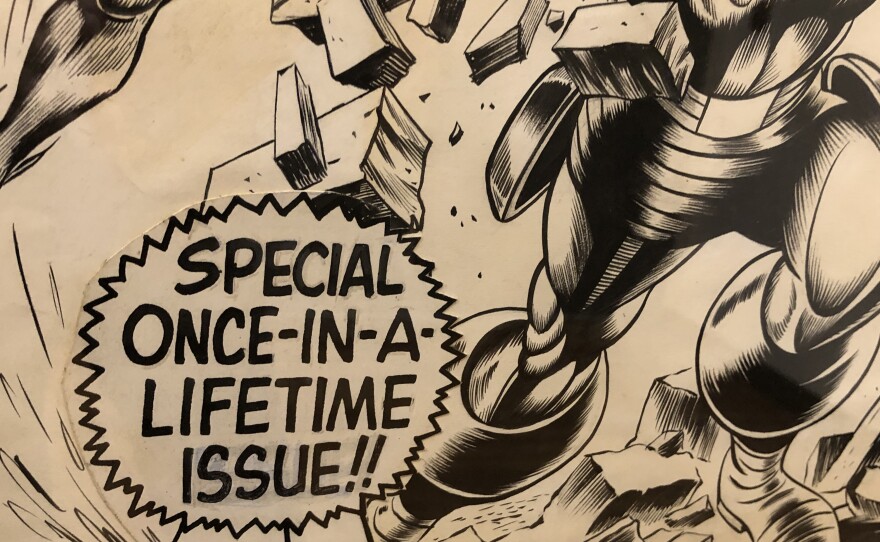Comic-Con Museum has just extended the run of its Excelsior: The Life and Legacy of Stan Lee exhibit to April. Earlier this month it added new original art to the collection honoring the late founder and editor-in-chief of Marvel Comics.
Stan Lee’s career spanned more than six decades. As one of the icons of the comics industry, it’s fitting that Comic-Con Museum has an exhibit dedicated to him.
"Stan was inarguably the most important editor and writer and co-creator of comic books and comic book superheroes in history," curator Michael Uslan exclaimed. "It is my claim that he and his co-creators — Jack Kirby, Steve Ditko, and many of the other members of the Marvel bullpen — actually have created our modern day mythology. The ancient gods of Greece, Rome, Egypt all still exist. Except today, thanks to Stan and the group, they wear spandex and capes."
You can see the origins of some of that mythology in the new Curator Corner, featuring some historic original art. That any of this art still exists is amazing, since comic books were once a denigrated art form.
"They were looked down upon by society," Uslan recalled. "Starting in the mid-1950s, there was a public outcry in America against comic books because there was a post-World War II rise of juvenile delinquency in America, and something had to be blamed for it. So it must have been comic books that caused this generation of young people to turn into juvenile delinquents. I mean, comic books were being burned, reminiscent of Nazi Germany in the 1930s, and these artists had to endure that."

But now comic books are recognized as a legitimate American art form that the Comic-Con Museum is thrilled to celebrate. On Jan. 6, it created Curator Corner to highlight some new additions of original art that Uslan is eager to discuss.

Uslan, who sometimes speaks in comic book exclamations, said, "I have to start with what, to me, is like looking at the Mona Lisa of the comic book world. It is an original page of Jack Kirby art from 1963, from 'X-Men Number One,' the comic book that introduced the world to Professor X, Cyclops, the Beast, Iceman, Angel, Marvel Girl, and a supervillain called Magneto. So that's my 'wow' item for starters."
Another new addition is the original artwork for a cover done by Gene Colon and Bill Everett.

"This is the historic cover to 'Iron Man' and 'Submariner' Number One and only," Uslan said. "It is the only issue ever published, from 1968."
There is also cover art from "The Invaders Number 1."
"Now, 'The Invaders' was a Golden Age group of superheroes. And when I say Golden Age, I'm talking about World War II," Uslan said. "The big Marvel superheroes back in those days were Captain America, the Human Torch, and the Submariner. And 'The Invaders' brought them all together into one super group."
The final new addition to the collection has a personal connection for Uslan. The art is a page of John Buscema's work from the "Avengers Number 52" in 1968, which is the issue where Black Panther joined the Avengers.

"Now, in this issue, I have a personal stake," Uslan said. "Because I wrote in a letter to Stan Lee, and he published it in 'Avengers Number 52.' Not only did it get me published, but Stan awarded me a vaunted Marvel 'No Prize.' It was an envelope saying, 'Congratulations, you've won a genuine no prize.' And you opened the envelope, and there was nothing in it."

That was a clever and cost-effective way of engaging fans. Uslan, who professionally may be better known for his DC connections as the producer who rebooted "Batman" in 1989, was 11 years old when he first met Lee.
"He became my mentor, my friend, and we got to work together creatively, and he has been a very, very important and influential part of my life," Uslan said. "That's why this exhibit is so important to me personally, and to all of geekdom and Marveldom and comic book fandom assembled."
Lee’s innovation to comics was to give his superheroes a flawed humanity, a noticeable contrast to the ideal archetypes that came before. His heroes also had to deal with such real world issues as racism, and that impacted his readers over the decades.
"For me, and for most of my friends and my kids and my kids' friends growing up, everybody really truly believes that these comic books helped mold our own sense of ethics and morality," Uslan said. "What a gift to give to one generation of children after the next, and that's one of the important things that Stan and his co-creator accomplished that they really don't get enough credit for."
Comic-Con Museum pays tribute to that legacy and the legacy of the artists who helped bring these amazing, uncanny, fantastic, incredible comic books to life.





